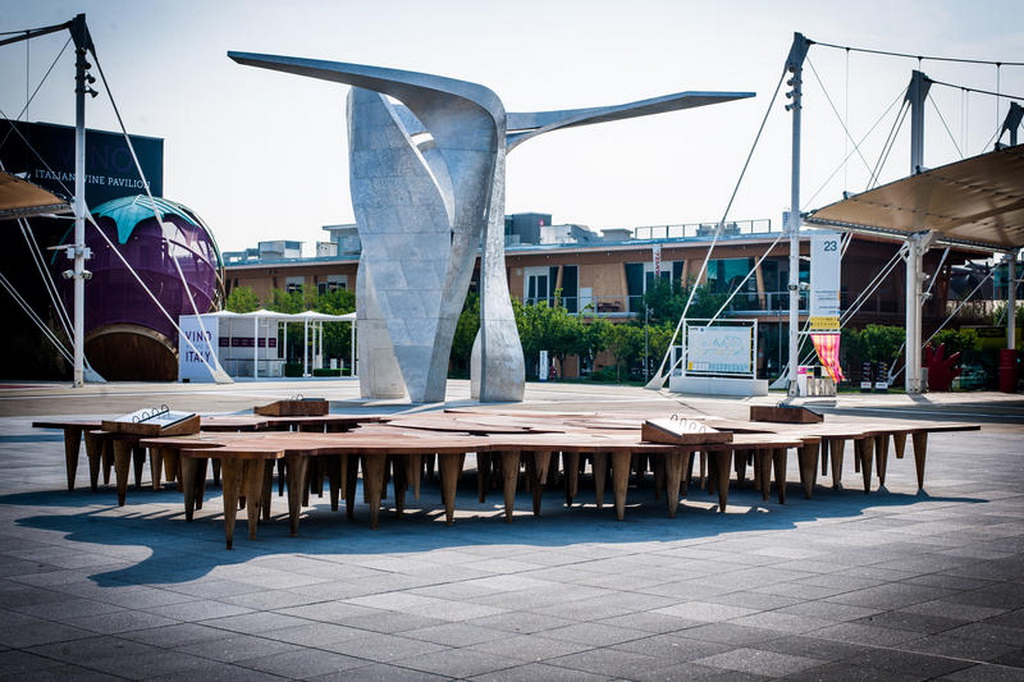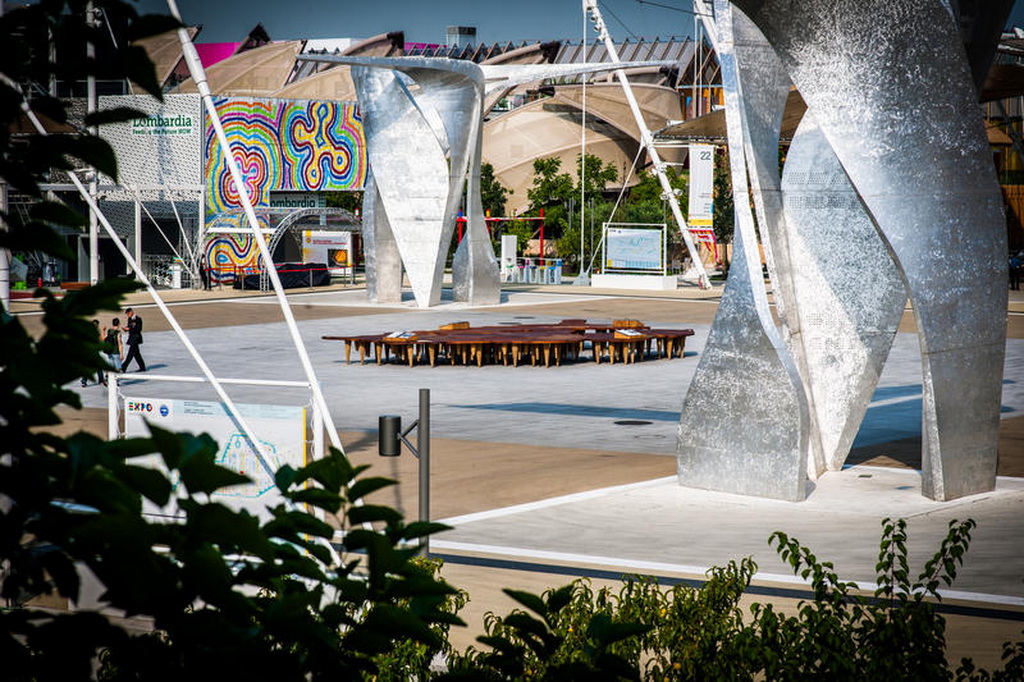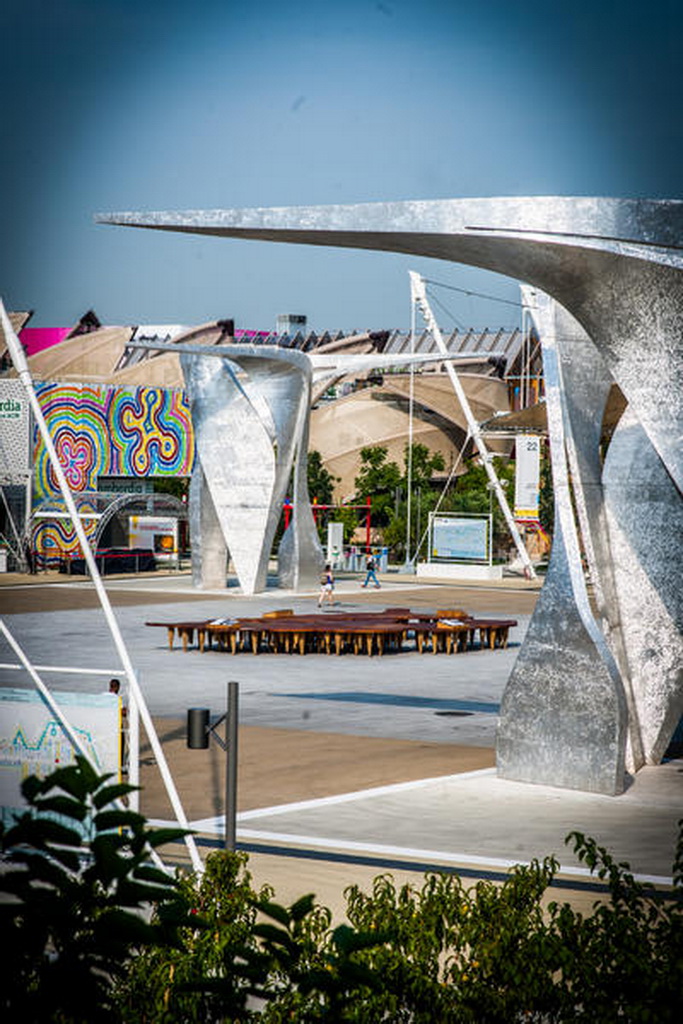Pangea table design by Michele De Lucchi and made by Riva 1920 for Expo 2015, is now on display in the amazing and central location of Piazza Italia, the heart of Expo 2015.

The project takes inspiration and its name from Pangea, the single continental mass which is thought to have included all the lands above sea-level and which in later geological eras broke up to give today’s continents.
The 80 square meters top in Kauri, millennial wood coming from New Zealand, is made of 19 shaped pieces and it is supported by 271 legs in Briccola wood, oak posts retrieved from Venice Lagoon.
The core of the realization of this project is the respect for the environment and the safeguarding of our arboreal heritage by using recycled timber, something which has always been a distinguishing theme of our company.

Pangea “How it’s made”: https://player.vimeo.com/video/132797942
The over 140 countries involved will all showcase the best of thos initiatives that represent their concrete response to vital needs: ensuring for all a supply of food that is healthy, adequate and guaranteed, and which is produced in a way that is ecologically sustainable for the Planet as a whole.
Michele De Lucchi’s project symbolises the need for a return to our original condition, free of state borders, prejudice, differences between one people and another and without racial and class discrimination, unified around the universal theme of food.

This table represents a moment of dialogue, an encounter, between leading figures and activists in the international community who can compare and exchange ideas relating to the principal challenges facing mankind, to the processes governing production and to the themes of equality and fairness in the allocation of the resources our planet provides.
Central to the realisation of this project is respect for the environment and the safeguarding of our arboreal heritage by using recycled timber, something which has always been a distinguishing theme of our company.
Glued planks of Kauri wood, thousands of years old, buried in swamps in its native New Zealand and used here for the top, and “Briccole”, marker posts retrieved from the lagoon of Venice used here for the 271 legs supporting the structure as a whole..
The surface of the table, composed of 19 pieces with irregular contours that all fit together like an outsize jigsaw puzzle, has been sanded in such a way as to highlight to the beautiful grain of this extraordinary wood.
To create the table we have used vinyl-based adhesives, which, since they contain no formaldehyde pose no danger either to the environment or to humans; the top is finished in natural oils.
The weight of the whole is about 6 tons and it took nearly fifty days to produce.

Riva 1920 has created an all-embracing experience, a shining example of the techniques embodied in the traditions of wood working.
” The table, a theatre of the world” by Davide Rampello
Where the lands meet is where the sharing happens.
The table is an ancient symbol of unity, cohesion and open exchange. Mankind has always derived enjoyment, celebrated and, above all, recounted experiences while seated around a table. From Plato’s Symposium to Dante’s Banquet, the stories that have been told at the dinner table have enriched the world.
This table is a Pangea, the supercontinent that held together the land above water two hundred million years ago (from the Greek π?ν, everything, and Γα?α, land, that is “all the land”). The precious ancient wood of which it is made is a metaphor for the unity of all peoples in relation to the universal theme of food.
Thus the banquet table becomes the site of a theatre of peace, where mankind sits together in unity before an uninterrupted succession of dishes from all over the world, which, like the scenes in a great universal drama, together tell our common story.

“From Milan to Tahiti by tram” by Michele De Lucchi
They are called tectonic plates. It is the theory according to which all the land above the level of the sea, today the continents of Africa, Europa, Asia, the Americas, Australia and all the small islands of the Pacific, were once one big island in the middle of one enormous ocean. The supercontinent was called Pangea and the superocean we call Pantalassa; and so it was until the end of the Paleozoic period, about 250 million years ago. In other words, it was when you could take the tram from Milan to Tahiti! That was a long time ago, of course, but geological science has proven it to be definitely true. Pangea started to break up in the Mesozoic era; this process is still active and so our tram ticket will have to go unused for many years to come, that’s certain. The separation and the drift of the land masses has resulted in the current continental configuration, the oceanic basins, the civilisations and the different ways we have of thinking and interpreting reality and non-reality.
The Pangea table can be seen as the reconstruction of how the planet looked in that happy epoch when the lands, oceans, peoples and nature were joined together. It is composed of many separate individually shaped tables each with the highly original form of the supposed continents. The tables have many legs, proof that everything is always in motion; our task is simply to keep our balance
Project: Michele De Lucchi
Team: Angelo Micheli (head of project), Marcello Biffi, Alessandra De Leonardis, Francesco Forcella
